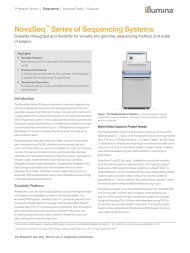Abstracts
ngsfinalprogram
ngsfinalprogram
Create successful ePaper yourself
Turn your PDF publications into a flip-book with our unique Google optimized e-Paper software.
Poster <strong>Abstracts</strong><br />
contiguity information in short-read sequencing.<br />
This limitation also impedes metagenome<br />
assembly, since one cannot tell which sequences<br />
originate from the same species within<br />
a population. We have overcome these bottlenecks<br />
by adapting a chromosome conformation<br />
capture technique (Hi-C) for the deconvolution<br />
of metagenomes and the scaffolding of de novo<br />
assemblies of individual genomes. In modeling<br />
the 3D structure of a genome, chromosome<br />
conformation capture techniques such as Hi-C<br />
are used to measure long-range interactions of<br />
DNA molecules in physical space. These tools<br />
employ crosslinking of chromatin in intact<br />
cells followed by intra-molecular ligation,<br />
joining DNA fragments that were physically<br />
nearby at the time of crosslink. Subsequent<br />
deep sequencing of these DNA junctions generates<br />
a genome-wide contact probability map<br />
that allows the 3D modeling of genomic conformation<br />
within a cell. The strong enrichment<br />
in Hi-C signal between genetically neighboring<br />
loci allows the scaffolding of entire chromosomes<br />
from fragmented draft assemblies.<br />
Hi-C signal also preserves the cellular origin<br />
of each DNA fragment and its interacting partner,<br />
allowing for deconvolution and assembly<br />
of multi-chromosome genomes from a mixed<br />
population of organisms. We have used Hi-C<br />
to scaffold whole genomes of animals, plants,<br />
fungi, as well as prokaryotes and archaea. We<br />
have also been able to use this data to annotate<br />
functional features of microbial genomes, such<br />
as centromeres in many fungal species. Additionally,<br />
we have applied our technology to<br />
diverse metagenomic populations such as craft<br />
beer, bacterial vaginosis infections, soil, and<br />
tree endophyte samples to discover and assemble<br />
the genomes of novel strains of known<br />
species as well as novel prokaryotes and<br />
eukaryotes. The high quality of Hi-C-based<br />
assemblies allows the simultaneous closing of<br />
numerous unculturable genomes, placement of<br />
plasmids within host genomes, and microbial<br />
strain deconvolution in a way not possible<br />
with other methods. Reference: Burton JN*,<br />
Liachko I*, Dunham MJ, Shendure J. Specieslevel<br />
deconvolution of metagenome assemblies<br />
with Hi-C-based contact probability maps. G3.<br />
2014, May 22;4(7):1339-46.<br />
n 101<br />
AN AUTOMATED WGS PIPELINE FOR<br />
ANALYSIS OF BACTERIAL GENOMES<br />
M. Thomsen 1 , H. Hasman 2,3 , A. Petersen 3 , R.<br />
Skov 3 , O. Lund 1 , A.R. Larsen 3 and F.M. Aarestrup<br />
2 ;<br />
1<br />
Danish Technical University – Systems Biology,<br />
CBS, Lyngby, Denmark, 2 , Danish Technical<br />
University – National Food Institute,<br />
Lyngby, Denmark, 3 Statens Serum Institut,<br />
Copenhagen, Denmark.<br />
Background New approaches within diagnostics<br />
and surveillance for species identification,<br />
clonal clustering, and identification<br />
of resistance genes are based whole genome<br />
sequencing (WGS). The Centre for Genomic<br />
Epidemiology (CGE) has been developing<br />
stand-alone web-tools for handling WGS information<br />
for outbreak investigation, epidemiological<br />
surveillance and diagnostics.<br />
Material and methods Based on previously<br />
published web-based CGE tools we developed<br />
a pipeline for automatic analysis of WGS data<br />
from bacterial isolate samples https://cge.cbs.<br />
dtu.dk/services/CGEpipeline-2.0/). The bacterium<br />
analysis pipeline (BAP) automatically<br />
identifies the bacterial species and identify<br />
the multilocus sequence type (MLST), spa<br />
type (S. aureus only), serotype (E. coli only)<br />
and antimicrobial resistance genes. To test the<br />
BAP, a set of 101 S. aureus strains originating<br />
from bacterial infections at Danish hospitals<br />
submitted to Statens Serum Institute (SSI) for<br />
genotypic by traditional Sanger sequencing<br />
were subjected to WGS on an Illumina HiSeq<br />
to a minimum coverage of 30x and assembled<br />
by Velvet prior to being uploaded to the<br />
BAP. Draft genomes including a mandatory<br />
metadata spread sheet containing sequenc-<br />
108<br />
ASM Conferences



